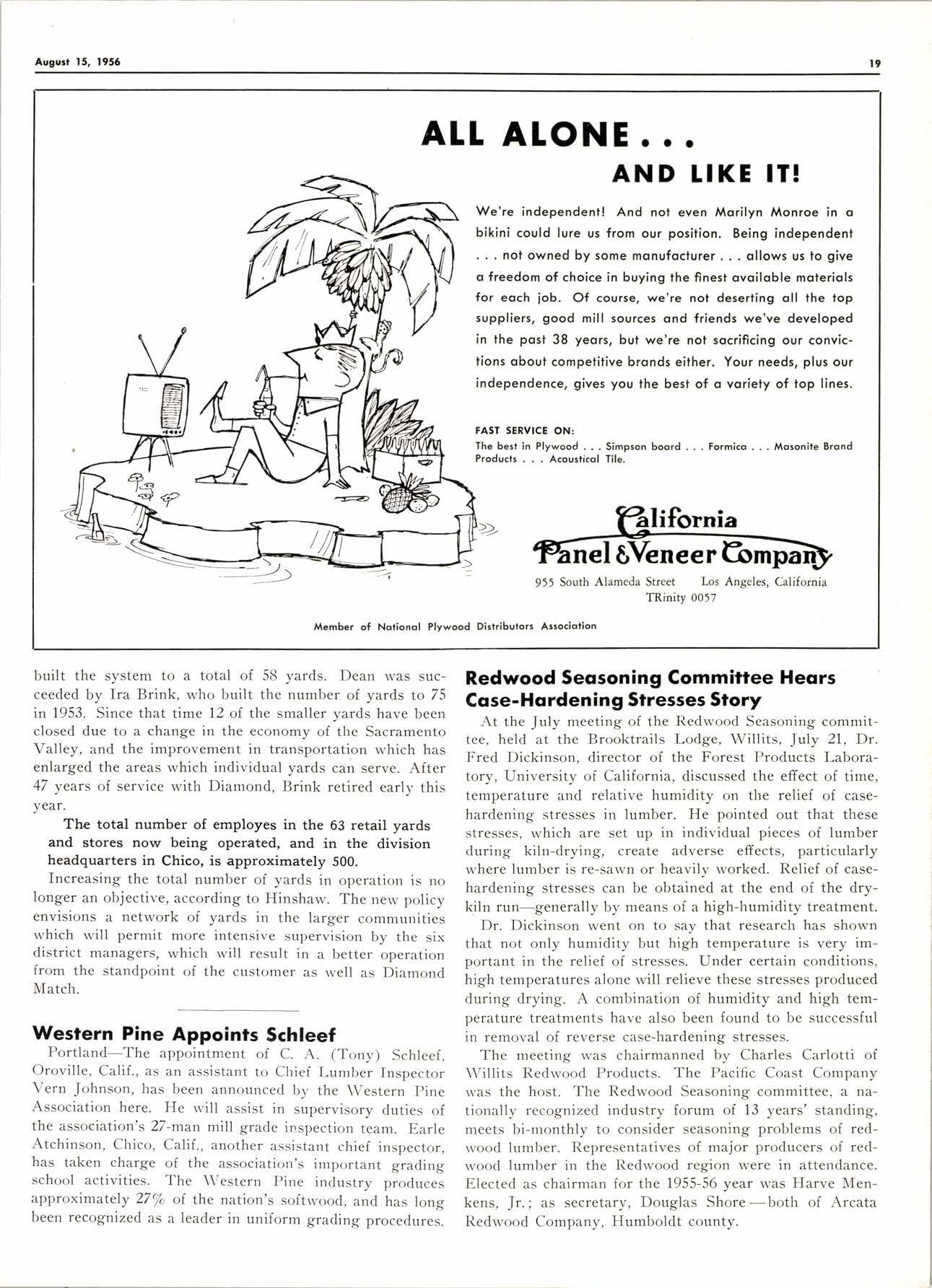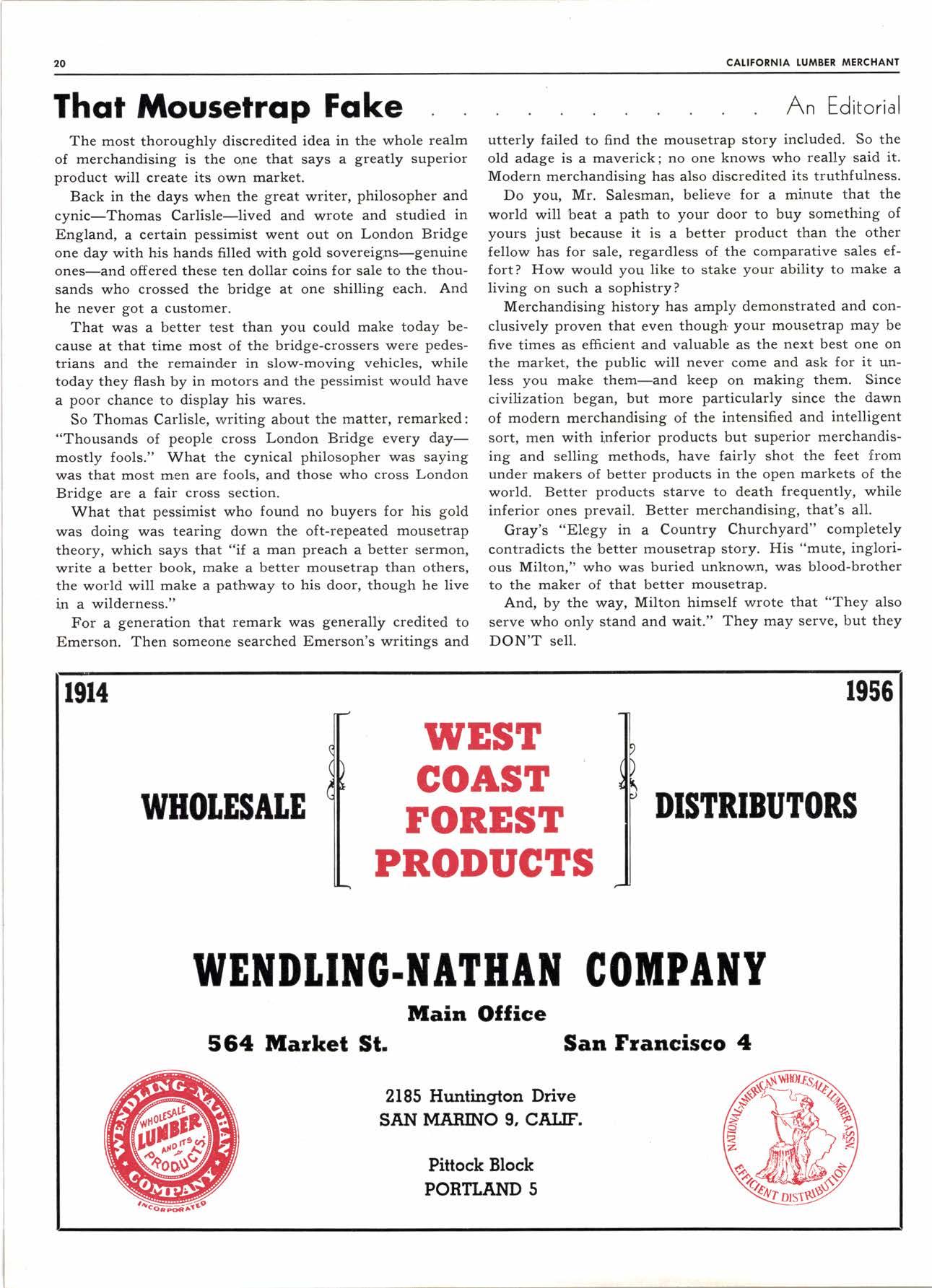
4 minute read
Att AIONE O ..
AND LIKE IT!
We're independent! And not even Morilyn Monroe in o bikini could lure us from our position. Being independent . not owned by some mqnufoclurer qllows us to give o frbedom of choice in buying the finest ovoiloble moleriols for eoch iob. Of course, we're not deserting oll the top suppliers, good mill sources ond friends we've developed in the post 38 yeors, bul we're nol sqcrificing our conviclions qbout competitive brqnds either. Your needs, plus our independence, gives you the best of o voriely of top lines.
lifornia nel e,Veneer eorFi
951 South Alameda Street Los Angeles, California TRinity 0057
Member of Notionol Plywood Di3tributors Associotion built the system to a total of 58 yards. Dean was succeeded by Ira Brink, who built the number of yards to 75 in 1953. Since that time 12 of the smaller yards have been closed due to a change in the economy of the Sacramento Valley, and the improvement in transportation which has enlarged the areas which individual yards can serve. After 47 years of service with Diamond, Brink retired early this year.
Th€ total number of employes in the 63 retail yards and stores now being operated, and in the division headquarters in Chico, is approximately 500. Increasing the total number of yards in operation is no longer an objective, according to Hinshaw. The new policy envisions a network of yards in the larger communities which will permit more intensive supervision by the six district managers, which will result in a better operation from the standpoint of the customer as well as Diamond Match.
Wesfern Pine Appoints Schleef
Portland-The appointment of C. A. (Tony) Schleef, Oroville, Calif., as an assistant to Chief Lumber fnspector Vern Johnson, has been announced by the Western pine Association here. He will assist in supervisory duties of the association's 27-man mill grade inspection team. E,arle Atchinson, Chico, Calif., another assistant chief inspector, has taken charge of the association's important grading school activities. The Western Pine industry produces approximately 27/' of the nation's softwood, and has long been recognized as a leader in uniform grading procedures.
Redwood Seosoning Gommittee Heors Cose- Horden in g Stresses Story
At the July meeting of the Redwood Seasoning committee, held at the Brooktrails Lodge, Willits, July 21, Dr. Fred Dickinson, director of the Forest Products Laboratory, IJniversity of California, discussed the effect of time, temperature and relative humidity on the relief of casehardening stresses in lumber. He pointed out that these stresses, which are set up in individual pieces of lumber during kiln-drying, create adverse effects, particularly where lumber is re-sawn or heavily worked. Relief of casehardening stresses can be obtained at the end of the drykiln run-generally by means of a high-humidity treatment.
Dr. Dickinson went on to say that research has shown that not only humidity but high temperature is very important in the relief of stresses. Under certain conditions, high temperatures alone will relieve these stresses produced during drying. A combination of humidity and high temperature treatments have also been found to be successful in removal of reverse case-hardening stresses.
The meeting was chairmanned by Charles Carlotti of Willits Redwood Products. The Pacific Coast Company r,vas the host. The Redwood Seasoning committee, a nationally recognized industry forum of 13 years' standing, meets bi-monthly to consider seasoning problems of redwood lumber. Representatives of major producers of redwood lumber in the Redwood region were in attendance. Elected as chairman for the i955-56 year was Harve Menkens, Jr. ; as secretary, Douglas Shoreboth of Arcata Redwood Company, Humboldt county.
Thot Mousetrop Fqke
The most thoroughly discredited idea in th'e whole realm of merchandising is the one that says a greatly superior product will create its own market.
Back in the days when the great writer, philosopher and cynic-Thomas Carlisle-lived and wrote and studied in England, a certain pessimist went out on London Bridge one day with his hands filled with gold sovereigns-genuine enes-and offered these ten dollar coins for sale to the thousands who crossed the bridge at one shilling each. And he never got a customer.
That was a better test than you could make today because at that time most of the bridge-crossers were pedestrians and the remainder in slow-moving vehicles, while today they flash by in motors and the pessimist would have a poor chance to display his wares.
So Thomas Carlisle, '"vriting about the matter, remarked: "Thousands of people cross London Bridge every daymostly fools." What the cynical philosopher was saying was that most men are fools, and those who cross London Bridge are a fair cross section.
What that pessimist who found no buyers for his gold was doing was tearing down the oft-repeated mousetrap theory, which says that "if a man preach a better sermon, write a better book, make a better mousetrap than others, the world will make a pathway to his door, though he live in a wilderness."
For a generation that remark was generally credited to Emerson. Then someone searched Emerson's writings and utterly failed to find the mousetrap story included. So the old adage is a maverick; no one knows who really said it. Modern merchandising has also discredited its truthfulness.

Do you, Mr. Salesman, believe for a minute that the world will beat a path to your door to buy something of yours just because it is a better product than the other fellow has for sale, regardless of the comparative sales effort? How would you like to stake your ability to make a living on such a sophistry?
Merchandising history has amply demonstrated and conclusively proven that even though your mousetrap may be five times as efficient and valuable as the next best one on the market, the public will never come and ask for it unless you make them-and keep on making them. Since civilization began, but more particularly since the dawn of modern merchandising of the intensified and intelligent sort, men with inferior products but sup.erior merchandising and selling methods, have fairly shot the feet from under makers of better products in the open markets of the world. Better products starve to death frequently, while inferior ones prevail. Better merchandising, that's all.
Gray's "Elegy in a Country Churchyard" completely contradicts the better mousetrap story. His "mute, inglorious Milton," who was buried unknown, was blood-brother to the maker of that better mousetrap.
And, by the way, Milton himself wrote that "They also serve who only stand and wait." They may serve, but they DON'T sell.










